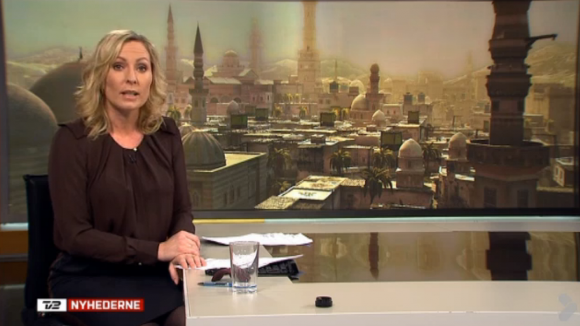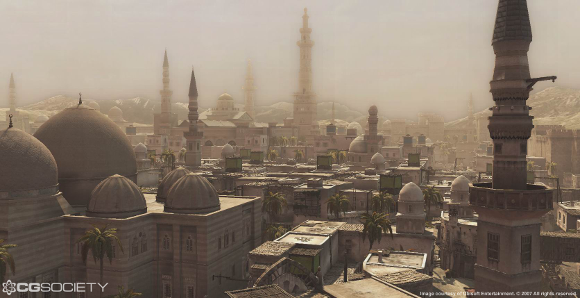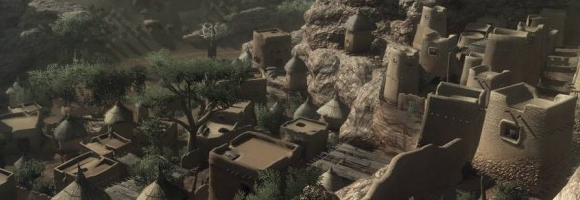damascus it is

On 26 February 2013 TV2 of Denmark needed a backdrop for a report on the current conflict in Syria. As it seems someone at the station searched the web for a suitable picture and hit upon a beautiful vista of the old city of Damascus. But the picture shows Damascus as it most probably has looked during the time of the ↑third crusade (1189-1192). Above that the picture doesn’t depict anything from the empirical world, but is a still from the computer game ‘↵Assassin’s Creed‘ (Ubisoft Montreal 2007). Quite tell-tale is the wooden beam attached to the minarett at the right. It’s a gameplay element from which you can perform the ‘↑leap of faith.’ Another gameplay element clearly visible are the rooftop gardens, those greenish cubes scattered atop buildings in the picture. Into this cubes, veiled by curtains, the character controlled by the player can ‘vanish’ after he has broken the line of sight between him and his persecutors.
But the irony goes even a step further. Most probably the people at TV2 hit upon the image via a Google image search, leading them to the subpage ‘↑Damascus‘ at the fan-driven ‘Assassin’s Creed’ wiki. The screencap wasn’t taken by a gamer, though. Rather it was made by Ubisoft staff and then given to the CGSociety for their 18 October 2007 feature ↑Assassin’s Creed: CGSociety production focus by Paul Hellard (the picture in question is to be found at the feature’s second page). The article is about the creation of the game’s environments, artistic blends of fantasy and historic realism …

The whole thing of course was a slip by a staff member, and hence may not happen too often—although the BBC just recently made a ↑similar fault, also concerning Syria. Nevertheless I like to see said slip as a symptom, because several associations came to my mind.
Years ago I was invited to give a lecture on ‘Computer games and violence’ at the Bayreuth International Graduate School of African Studies (↑BIGSAS). The audience was composed mainly of doctoral students from diverse African universities. My talk’s focus was pretty much on competitive multiplayer first-person shooters, so I showed them pictures from e.g. ‘↑Quake III Arena‘ (Q3A; id Software 1999). The fantasy/horror/scifi environments of the Quake series hardly really resemble anything from our empirical world. Especially when the graphics are stripped of all detail by video settings usually employed in competitive playing. In consequence there was no recognition and my listeners could follow the topic emotionally detached. But then I showed pictures of one of the most popular ‘↑Counter-Strike‘ (CS; Valve Corporation 2000 [1999]) maps, and there was recognition:

This is a panorama view, made by ↑Zlandael, of the ‘↑Counter-Strike: Source‘ (CSS; Valve Corporation 2004) version of the map de_dust. A generic vista of a Near East, Northern, or Subsaharan Africa setting. The members of the audience at BIGSAS were perfectly aware that we were looking at an artificial topography following the ruleset of the game. What bothered them was the styling, resembling settings from their African countries of origin. Settings now used as an arena of violence, for a firearm battle between two teams labeled ‘terrorist’ and ‘counter-terrorist.’ Granted, there are CS and CSS maps which are e.g. Italian themed, and whatyouhave. Still, de_dust since years is one of the most popular maps, its looks well known outside of the CS community, almost having become synonym to CS. So, back to the question the audience back then asked me: Why is it that de_dust is styled like that? Well, I guess because by decades of news coverage pictures of ‘the’ Middle East have become inextricably linked with urban warfare and close quarter battle—within the minds of viewers from the North Atlantic societies. ‘Orientalism’ (Saïd 1978) redux.
Something similar is true for Africa at large. Following the TV news coverage you get the impression that Africa is a continent exclusively filled with corrupt governments, warlords, unstable, failed, and rogue states. An anarchic world of weapons and violence, the ideal setting for big adventure—like in ‘↑Far Cry 2‘ (FC2). Here is a screencap from the latter, depicting a Dogon village:

I wouldn’t be surprised when a screenshot like that from FC2 would creep up as a backdrop behind some anchorwoman delivering a report on Mali and the Dogon. There is a plethora of pictures of Dogon architecture online, especially because Dogon country is a major attraction for tourists visiting Mali. But in most of the cases the Dogon village screenshots from FC2 stand out. Just like the AC vista of ancient Damascus stood out for the staff member of Denmark’s TV2—little wonder, as it was created by top professional artists from the industry. Composition and lighting of the artificial pictures are not only superior, but follow Orientalist æsthetics.
All kinds of imaginary flow around the globe within the -scapes Appadurai (1996) proposed, recombine, influence, produce, and reproduce each other. It’s just like in a novel by Philip K. Dick—you never can be sure on which plane of reality you currently are.

